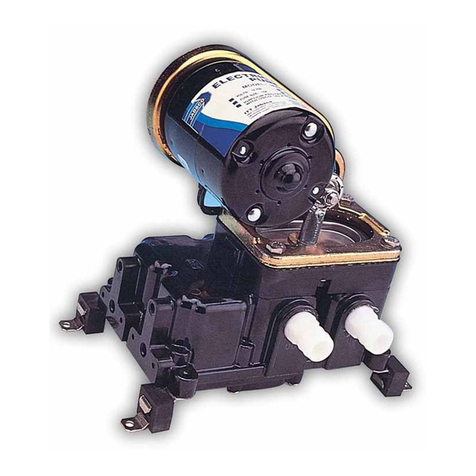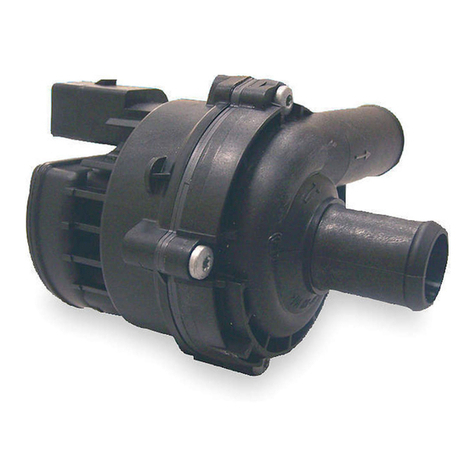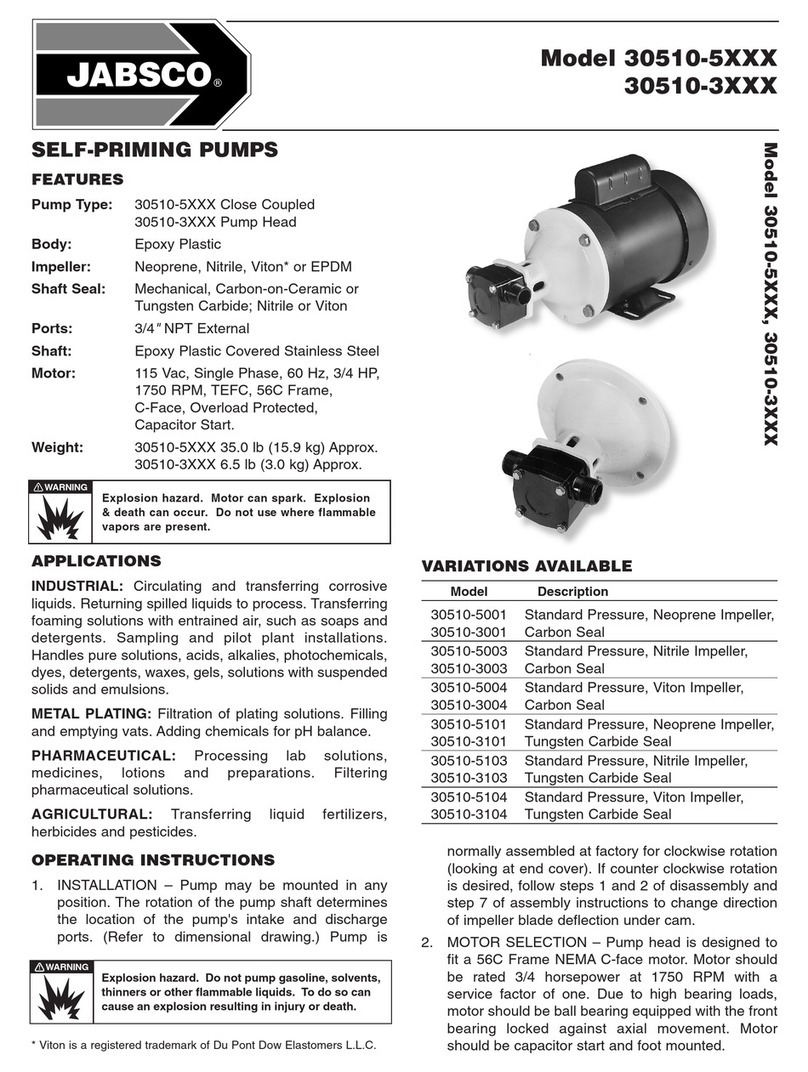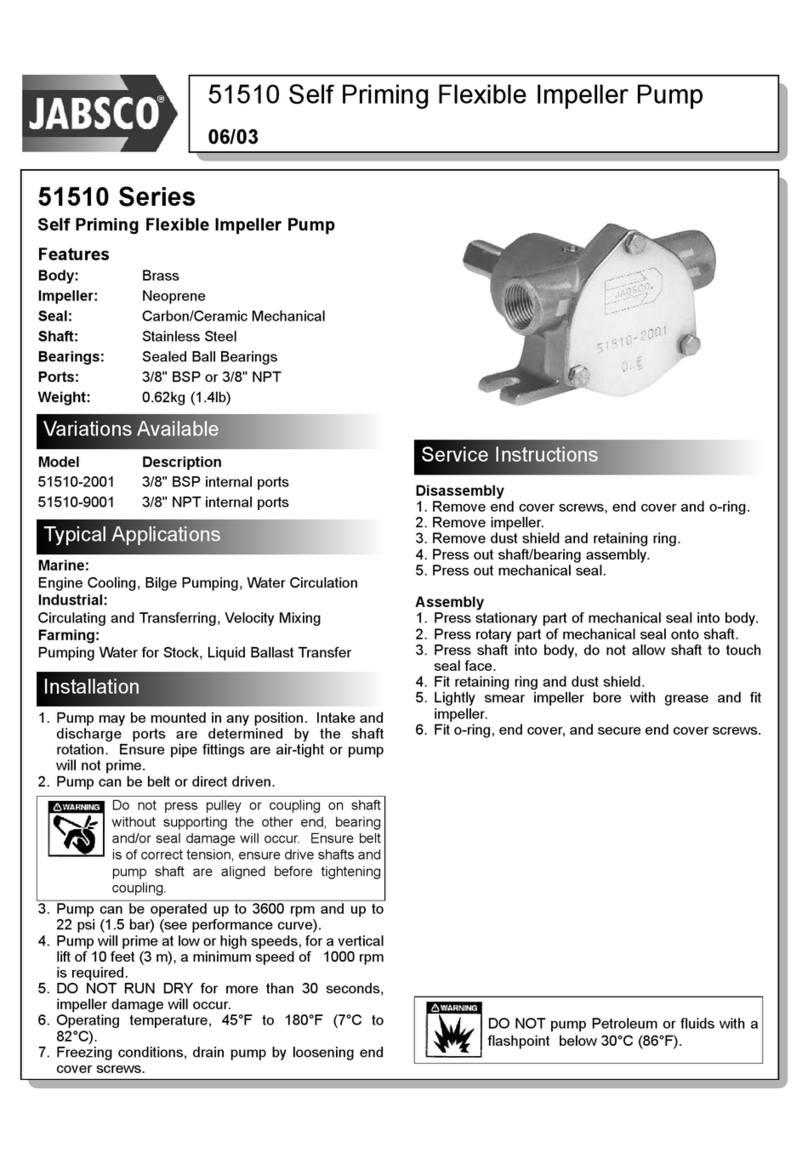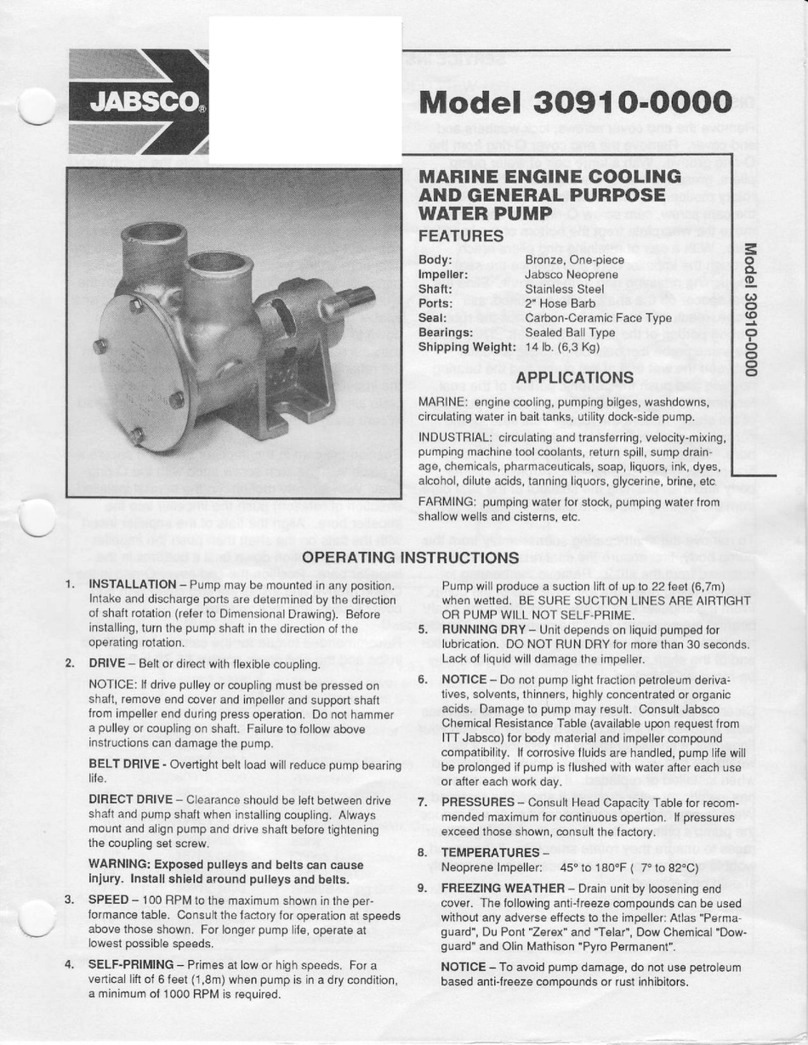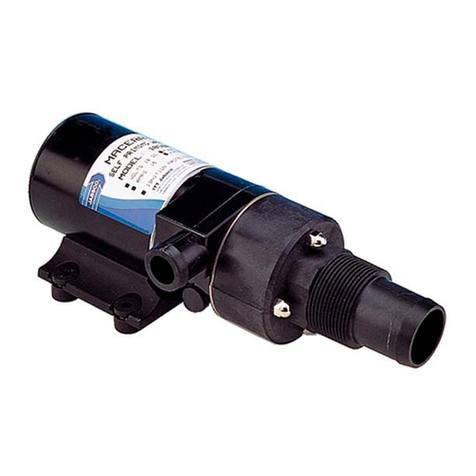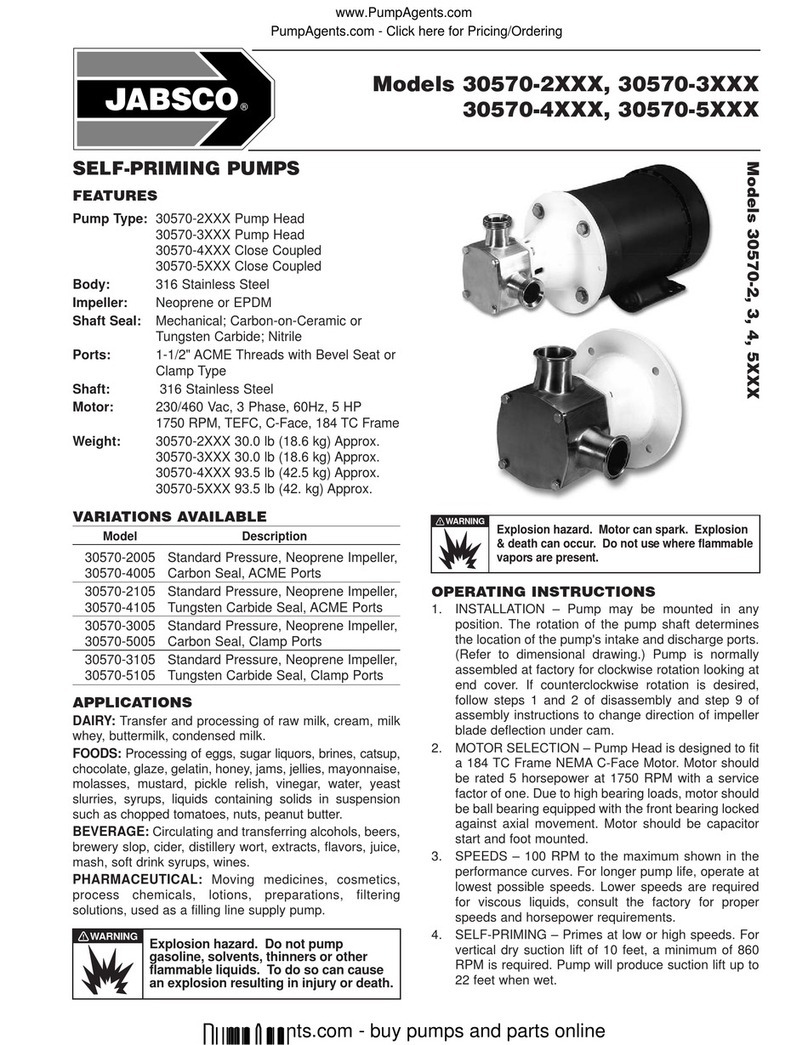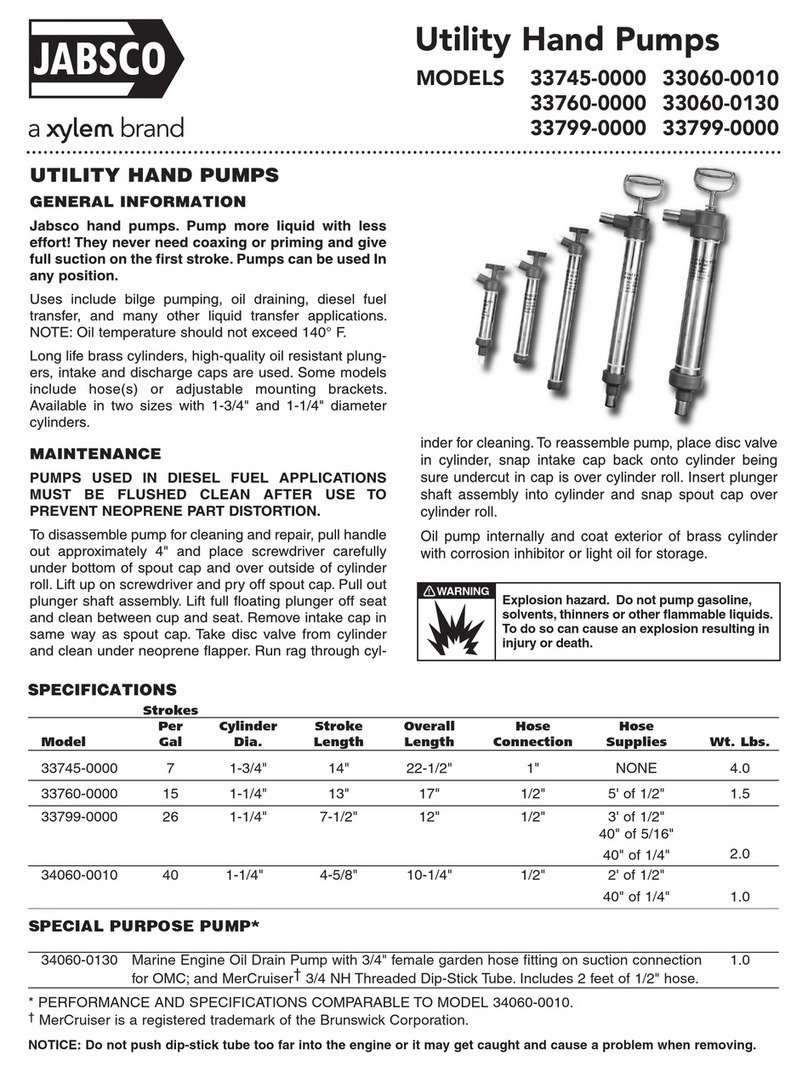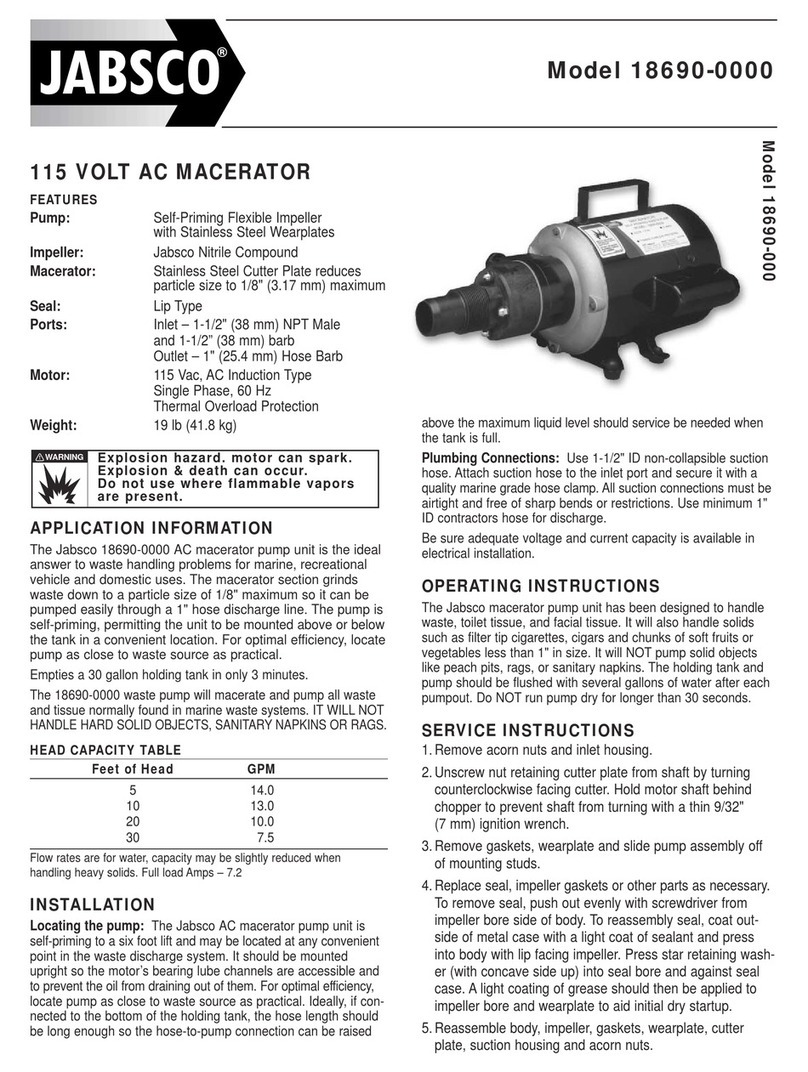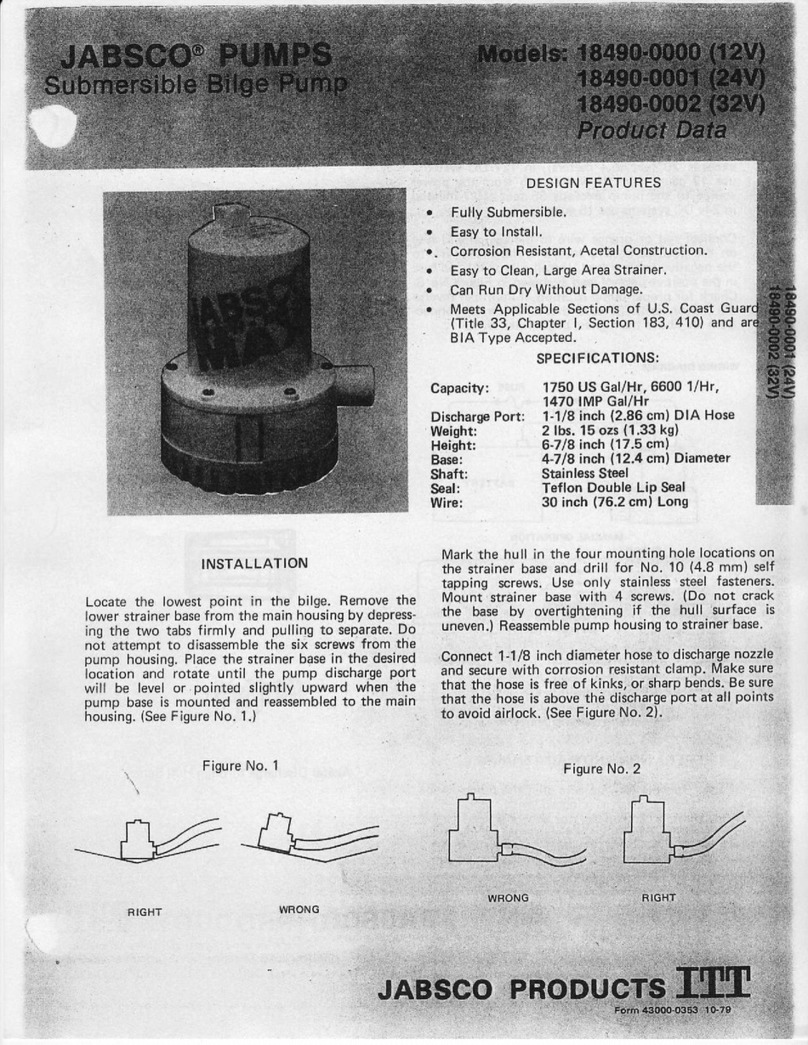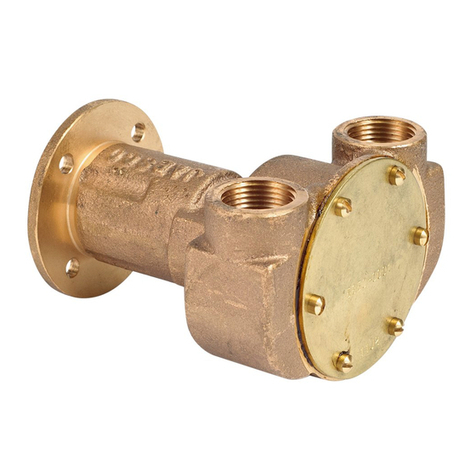
Grasp the pump body, wearplate and motor with one hand, holding
them together as an assembly. Then slide the mounting
lange/macerator housing off the pump body with the other hand
trying not to disturb the wearplate and damage the paper gaskets.
It may be necessary to gently tap on the flange with a plastic mal-
let to start it sliding off the pump body.
If the gaskets are damaged, they should be replaced with new
ones (provided) before attaching the new mounting flange/macera-
tor housing. To do this insert a blunt rod dowel into the discharge
hole in the pump body and push it against the impeller to prevent
the motor shaft from turning. Unscrew and remove the chopper
from the motor shaft. Lift the wearplate and gaskets from the pump
body and clean any paper residue which may stick to the wearplate
and body. Reassemble with new gaskets by reversing the proce-
dure.
Before assembling the new mounting flange/macerator housing to
the pump body, ensure the discharge port O-Ring is properly posi-
tioned in the O-Ring groove of the pump body. Secure the flange to
the pump body with the two shorter screws and the pump assem-
bly to the motor with the two longer screws.
Before removing the manual pump, flush the toilet for sufficient
time to ensure all waste is thoroughly flushed from the discharge
hose.
Remove the 3/4" inlet hose and toilet bowl link hose from the manual
pump. Detach the discharge elbow, flange and joker valve assembly
from the pump cylinder. It should not be necessary to remove the dis-
charge hose from the elbow.
Remove the screws which secure the pump assembly to the
toilet base and retain them to reattach the electric flush pump.
Remove the manual pump assembly and the base flapper
valve/gasket assembly with attached brass weight. The pump
and flapper valve may be disinfected and stowed away for emer-
gency use should the vessel lose electrical power.
Before assembling the electric flush pump to the toilet base,
attach the discharge elbow, flange and joker valve to the flush
pump discharge. Position the new pump base gasket (provided)
on the toilet base. Align the flush pump mounting flange with the
toilet base and secure it with the pump mounting screws.
Attach the 3/4" inlet hose to the inlet port (beneath the upper
pump pointing down). Do not connect the pump inlet to a pres-
surized water system. Attach the bowl link hose to the flush
pump discharge port (rear of upper pump pointing back). If the
bowl link hose is not long enough or is kinked, replace it with the
length of hose provided with the flush pump kit.
If the toilet is positioned below the waterline or may be below the
waterline at any angle of heel or trim, the plumbing must include
vented loops positioned above the waterline. To do this, remove
the length of hose which connects the flush pump with the bowl.
In its place install a length of hose long enough to connect the
flush pump to a vented loop fitting positioned a minimum of 8
inches above the waterline. Connect the other side of the vented
loop fitting to the bowl inlet elbow.
In below waterline installations with the discharge hose connect-
ed to a thru-hull fitting, the hose must rise up and be connected
to a vented loop positioned a minimum of 8 inches above the
waterline and then continue on to the discharge seacock. The
total rise of the discharge hose, however, must not exceed 6 feet
of head. If a vented loop fitting in the discharge hose positioned
at least 8" above the waterline results in a total discharge head
that exceeds 6 feet, the electric flush pump should not be
installed.
WIRING
The flush pump should be wired to the power source with an
electrical circuit independent of all other accessories. The total
length of wire should be kept to a minimum and the wire should
be sized in accordance with the following electrical specifications
chart. The wires, if not run through a conduit, should be support-
ed every 18 inches with non-metallic clamps.
NOTICE: Correct wire size and secure wire connections are
very important. Undersized wire and unsecured or corroded
wire connections will cause a reduction in pump performance
and possible pump failure.
The entire circuit should be protected by an appropriate
size circuit breaker or switch panel located as close to the
power source as possible.
Connect the red motor lead to positive and the black
motor lead to negative. When making connections to the
motor leads use only mechanical locking (crimp type) con-
nectors or equivalent and seal the connection with silicone or
heat-shrink tube to protect it from corrosion.
RATED NOMINAL FUSE WIRE SIZE PER LENGTH OF RUN*
VOLTAGE AMPS SIZE 0'-10' 10'-15' 15'-25' 25'-40' 40'-60'
12 24 25 12 10 8 6 4
24 13 15 16 14 12 10 10
*Length of run is the combined distance from the positive
power source to the flush pump and back to ground.
Wire sizes recommended will allow no more than a 5%
drop in voltage.
VENTED LOOP ILLUSTRATION
4. Remove the O-Ring around the discharge port.
5. Grip the flat of the shaft where it has been exposed by the
remove top pump assembly to prevent it from rotating.
Unscrew and remove the chopper and its lock washer.
6. Remove the wearplate and two gaskets from the
pump assembly.
7. Remove the pump body and impeller from the motor
then withdraw the impeller from the body.
8. Through the impeller bore side of the pump housing, push
evenly against the shaft seal to press it out of the bore.
WASTE PUMP REASSEMBLY:
1 .Press the lip seal into the seal bore of the pump body
with the open side of the seal facing the impeller bore.
2. Lubricate the impeller bore of the body and the motor
shaft with petroleum jelly then slide the pump body
onto the shaft.
3. Slide the impeller onto the shaft and with a counter-clock-
wise motion push the impeller into the impeller bore.
4. Position a new paper gasket, wearplate and second
paper gasket on the shaft against the pump body.
5. Grip the flat of the shaft on the top end of the motor to
prevent it from turning. Install the chopper lock washer
and the chopper on the bottom shaft.
6. Position the O-Ring in the O-Ring groove around the
discharge port.
7. Slide the macerator housing onto the pump body and
secure it with the two shorter screws.
8. Position the discharge flange on the same side of the motor
where the wire leads enter the case and secure the pump
assembly to the motor with the two longer screws.
FLUSH PUMP REASSEMBLY:
1. Press the lip seal into the bore of the pump body with
the open side of the seal facing the impeller bore.
2. Lubricate the impeller bore of the body and the motor
shaft with petroleum jelly.
3. Slide the pump body onto the shaft and secure it to the
motor with two screws. Slide the impeller onto the shaft
and with a clockwise rotary motion press it into the
impeller bore of the body.
4. Push the inlet control valve assembly into the cylinder
above the inlet port.
5. Position the switch spring on the spring locator post.
Insert the dowel pin in the switch and slide the pin in its
channel to position the switch. Connect the red power
leads to the switch.
6. Press the brass wearplate into the impeller bore area
ensuring the locator notch aligns with the locator tab in
the body.
7. Position the cork gasket over the top of the flush pump
housing. Position the flush pump cover on the housing
and secure it with the seven long screws. Hint: When
installing screws, press firmly downward on the screw
and rotate it counterclockwise until you feel the thread
‘click’ into its groove, then screw it in until tight.
8. Position the control knob in its socket and secure it with
one short screw. Install the Electric Flush Pump
Assembly on the toilet base by following instructions for
installation.
9. Attach the flush pump to waste pump bleed tube to the
lower and upper bleed ports.
OPERATION
NOTICE: Do not run pump dry for more than ten seconds.
To do so may result in damage to the pump impeller.
To flush the toilet simply turn the large flush control knob
clockwise to the flush position. In the flush position the
flush Pump provides rinse water to the bowl while the
waste pump simultaneously macerates and discharges
the waste. Hold it in the flush position long enough to
evacuate all waste.
To evacuate liquid from the bowl so it will not slosh while
underway, turn the flush control knob counterclockwise to
the drain position. In the drain position the flush pump will
lower the liquid level to the bottom of the china bowl while
incoming rinse water is reduced to a minimum.
If the toilet bowl is empty, a small amount of water may be
added to the bowl prior to use by turning the flush control
knob to the flush position.
The waste pump is designed to handle waste and toilet
tissue (either household type tissue or Marine/RV water
soluble tissue is acceptable) but it will not handle sanitary
napkins, tampons or hard solid objects.
SERVICE INSTRUCTIONS
1. Disconnect the electrical power to the flush pump.
2. Detach the discharge elbow, flange and joker valve
3. Remove the inlet hose and toilet bowl link hose from
the flush pump.
4. Remove the screws that attach the flush pump to the
toilet base and lift the pump assembly from the base.
FLUSH PUMP DISASSEMBLY:
1. Remove the control knob screw and the control knob.
2. Remove the seven screws which attach the flush pump
cover assembly to the pump body and lift off the cover
assembly and the cork gasket.
3. Lift the brass wearplate and the flushing pump impeller
out of the impeller bore.
4. Carefully lift the switch from the pump housing taking
care not to lose the positioning dowel pin and gently
disconnect the red wire leads.
5. Using a blunt punch or small piece of dowel inserted in
the inlet port, push upward on the control valve assem-
bly to dislodge it from the flush pump housing.
6. Remove the two screws which secure the flush pump
housing to the motor and lift the pump housing off
the motor.
7. Through the impeller bore side of the pump housing,
push evenly against the shaft seal to press it out of the
seal bore.
WASTE SYSTEM DISASSEMBLY:
1. Remove the flush pump to waste pump bleed tube.
2. Remove the four screws that secure the macerator
housing and pump assembly together and to the motor.
Note that they are two different lengths with
the longer screws securing the pump assembly to
the motor.
3. Grasp the waste pump body and motor then pull the
macerator housing off the pump body.

